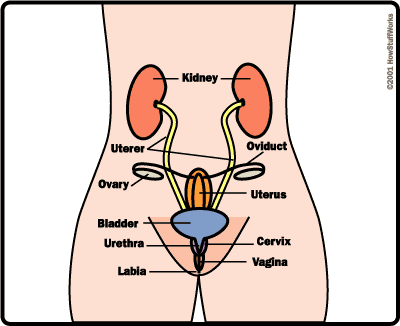Female Sex Organs
All of the female's sexual organs are located within her body except
the vulva. The vulva consists of two sets of folded skin (labia
major, labia minor) that cover the opening to the reproductive
tract, and a small nub of sensitive, erectile tissue (clitoris),
which is the remnant of the fetal penis (see sidebar).
The two ovaries are the major female sex organs, the
counterpart of the male testes. The ovaries make the eggs, or
oocytes, which are the female gametes, and produce
estrogen, the female sex hormone. Estrogen causes female
secondary sexual characteristics such as pubic hair, breast
development, widening of the pelvis and deposition of body fat
in hips and thighs. The ovaries are located in the abdomen.
|

Female sex organs
|
Eggs develop inside the ovary and are rreleased upon ovulation into a
tube (the oviduct or Fallopian tube) lined with
fingerlike projections. The egg travels through the Fallopian tube,
where fertilization can take place, to a muscular chamber called the
uterus.
The uterus is where the baby develops. It is made of smooth
muscle and is normally about the size and shape of a small pear
turned upside down. During pregnancy, it can stretch to about the
size of a basketball to hold the developing baby. The base of the
uterus (neck of the pear) is a muscular wall called the cervix.
In the cervix is a tiny opening, about the size of a pinhead, called
the external os. The external os is filled with a thick plug
of protein (mucus) that serves as a barrier to the entrance
of the uterus. The cervix leads into a smooth-muscle-walled tube
called the vagina, or birth canal.
The vagina connects the uterus to the outside of the body, and
its opening is covered by the labia. The vagina receives the male's
penis during sexual intercourse and delivers the baby during
childbirth. The vagina is normally narrow (except around the
cervix), but can stretch during intercourse and childbirth.
Finally, two sets of glands, the greater vestibular gland
(Bartholin's gland) and the lesser vestibular gland,
are located on either side of the vagina and empty into the labial
folds of skin. The secretions from these glands lubricate the labial
folds during sexual excitation and intercourse.
|
Development of Sex Organs
When we first develop, we have two sets of
organs: one that can develop into the female sex organs (Mullerian
duct) and one that can develop into the male sex organs (Wolffian
ducts). Which sex organs develop depends on the presence of
the male hormone testosterone (in humans, the default sex is
female):
- If the embryo is a male (XY chromosomes), then
testosterone will stimulate the Wolffian duct to develop male
sex organs, and the Mullerian duct will degrade.
- If the embryo is female (XX), then no testosterone is
made. The Wolffian duct will degrade, and the Mullerian duct
will develop into female sex organs. The female clitoris is
the remnants of the Wolffian duct.
- If the embryo is a male (XY), but there is a defect such
that no testosterone is made, then the Wolffian duct will
degrade, and the Mullerian duct will develop into
non-functional female sex organs.
Sex-organ development is determined by the third month of
development. |
Other Organs Involved in Sex
Although not located in the reproductive systems, two other organs
are important for sexual function in both males and females:
- The hypothalamus in the brain - The hypothalamus
has nerve cells that secrete a hormone called gonatotropin
releasing hormone (GnRH) into the blood vessels
leading to the anterior pituitary gland.
- The anterior pituitary gland just beneath the brain -
GnRH causes the anterior pituitary cells to release two hormones,
luteinizing hormone (LH) and follicle stimulating
hormone (FSH), into the general blood circulation. LH
and FSH act on the testes/ovaries to stimulate the making and
maturation of the sex cells and the production of sex hormones
(testosterone, estrogen, progesterone).
The nerve cells time-release small, low-level spurts of GnRH
every 90 minutes, which causes the anterior pituitary to secrete
small pulses of LH and FSH. The sex hormones from the testes/ovaries
give feedback to the hypothalamus and anterior pituitary to regulate
the secretion of GnRH, LH and FSH -- this interplay is called the
negative feedback control system. The chemical interplay between
the hypothalamus, anterior pituitary gland and the testes/ovaries is
important for sexual development, maintaining sexual function and
sexual reproduction. An error in this chemical interplay can be a
cause of infertility.